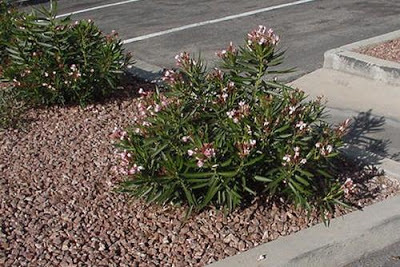Deep tree roots are important for
large trees. We know that these roots help to stabilize large trees, keeping
them anchored during high winds, and we know that it is important to get deep
rooting established in landscape trees when transplanted into urban residential
environments. Early research at the University of Arizona traced deep roots of native
mesquite to depths below 200 feet. More recent research suggests that these
deep roots are important for other reasons.
 |
| Sinker roots of mesquite not irrigated but close to a river |
When the researchers grouped these
plants by similar natural habitats, they found the average maximum rooting
depth to be 6 feet for cropland, 30 feet for deserts, 12 feet for conifer
forests, and nine feet for deciduous forests. When plants were again regrouped
into three groups based upon growth habit, then trees had an average maximum
depth of 20 feet, shrubs 15 feet and herbaceous plants (nonwoody) 7.5 feet. This
research showed that deep rooting is quite common in woody and herbaceous
species in natural habitats, far deeper than the traditional view held up until
now.
Deep
rooting is suspected, and research supports it, to be more important than just structurally
anchoring plants in the landscape. Research supports that they could be very important
for moving and releasing nutrients and water, both up and down, and redistributing
water and nutrients among different soil profiles. Water movement up roots into
drier surface soils may affect water use estimates trees and other plants
growing in their vicinity.
Many woody
plants utilize deep roots for water uptake, particularly when surface soils are
dry, but how they do this is not well understood. It was thought to be a
combination of water “pulled” up through the tree by evapotranspiration and
capillary action (like a soda straw) and little understood process called “root
pressure” (like a submersible pump). Measuring water moved from deep in the
soil by roots has always been difficult without disturbing the roots and accessing
these roots.
 |
| Roots of irrigated fruit tree pulled from orchard |
Research done in Texas on tree
roots of two native trees found that roots growing at 20 to 60 feet below the
soil surface contributed 20 – 50% of daily transpiration, depending on the
water content of surface soils. As surface soils dried, more water was taken
from deeper sources. All of this water from deeps soils was attributed to the
plant’s hydraulic lift. Large quantities of this water are lifted at night. When
hydraulic lift occurs at night then it is termed nocturnal hydraulic lift.
The
question then becomes, if available water is moved from deep sources through
deep roots during nighttime, when the plant is not transpiring for
transpiration the next day, then where is this water stored? Other research
indicates that water lifted from the deep soil profile is redistributed to dry,
shallower soils where it is stored and used in the future. Deep root water
transport varies with changes in the environment. When shallow soils become
wetted again due to rain and/or the plant’s need for water decreases, hydraulic
lift stops or is reduced dramatically.
Hydraulic lift is the passive
movement of water from roots where water is more available to roots or root
compartments where the soil is drier. It does not require plant energy. While
the majority of documented cases for hydraulic lift are in native plants in
desert or arid climates, recent studies (such as those in the Northeast with
Sugar Maple) indicate that hydraulic lift is not restricted to desert or arid
species or regions.
Release of water into the upper
soil layers has been shown to benefit plants neighboring roots responsible for
hydraulic lift. Because soils tend to dry from upper soil profiles downward and
nutrients are usually more plentiful in the upper soil layers, lifted water may
provide moisture to dry surface soils and enhance mineral uptake, beneficial
microorganism growth such as mycorrhizae, and uptake of nutrients by feeder
roots which typically occupy shallow soils. Some researchers feel that this is
a form of plant parasitism and may have been the primary selective force in the
evolution of this process. Hydraulic lift may also prolong or enhance root hair
activity by keeping them hydrated.
The direction of water movement in
deep roots may be upward, downward or horizontal depending on where soil
moisture is more limiting. The transfer of water
downwards by root systems, from lets say roots growing in wet shallow soils to
dry deep soils, has been termed downward
siphoning or inverse hydraulic lift;
the reverse of hydraulic lift.
Such downward movement through the
root system may allow growth of roots in otherwise dry soil at greater depths,
permitting more rapid establishment of some plants. The
amounts of water stored deep in the soil are not likely to be significant contributions
if plant drought is severe. However, downward transfer of water may be
important to plant establishment and the reduction of waterlogging in certain
soil types. Inverse hydraulic lift may facilitate root growth into deep soil
layers and transfer water away from neighboring, shallower-rooted competitors.
In addition to hydraulic lift,
where water is redistributed from moist depths to dry topsoil, or inverse
hydraulic lift which transfers water downward, the process of "hydraulic redistribution"
includes the transfer of water horizontally, from areas that are moist to areas
which are drier. In some locations and at some times of the year the subsurface
transfer of water through roots may actually represent more water than the
amount needed for transpiration.
How much
water can this represent? Researchers aren’t really sure but field measurements
of hydraulic lift in sugar maple in the Eastern U.S. have put these estimates
as high as 25 gallons per night but other studies indicate much higher values. It
is suspected that there is a great deal of competition for this water by
neighboring plants.





